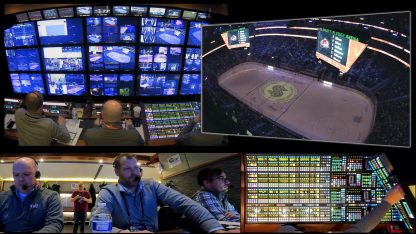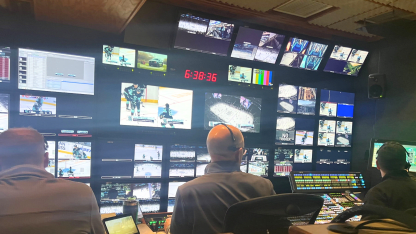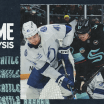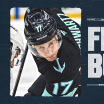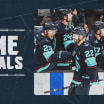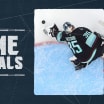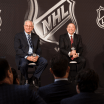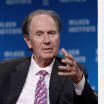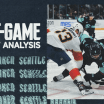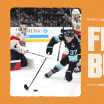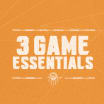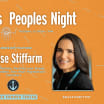Fans tuning into Seattle games on the greatly expanded Kraken Hockey Network are privy to a game-long conversation that is nothing short of informative, entertaining, fun, fast-moving, lively, and, let’s agree, second to none in the NHL.
Did we say fun? How about KHN analyst Eddie Olczyk explaining why new coach Dan Bylsma was looking downward after Edmonton tied up Wednesday’s preseason home finale at 2-2. Fans’ first thought: Oh, he’s upset about the goal and the tie score since the Kraken went up two to nothing on a Shane Wright spin-and-shoot-between-his-legs highlight-reel goal earlier in the period. Not the case, said Olczyk, explaining while also jabbing his good friend and supreme-play-by-play man, John Forslund.
“For people maybe newer to the game, when they see coaches looking down at their feet all the time,” said Olczyk, who was an NHL head coach in Pittsburgh for two seasons. “They're not looking at their shoes. They're looking at – you have nice shoes on tonight, Johnny –”
“I do,” said Forslund, embracing the comedic straight-man role.
“They're looking at a TV monitor down there,” continued Olczyk, not missing a beat. “They're looking at replays, trying to go to school on what’s going on. Work to be done, a lot of teaching points going on, especially here in the second period.”
On the ice, a whistle blows for a stoppage in play and the ensuing TV timeout.
“5:23, left in it from Seattle,” said Forslund, talking over an exquisite nighttime camera shot outside showing Climate Pledge Arena and the city skyline.
“Those look really nice, though,” said Olczyk. “They are nice. They look good.”
“You like these shoes?” asked Forslund, deftly reminding viewers about the subject matter.” They're comfortable.”
“You look comfortable,” said Olczyk as the telecast goes to a commercial break.
Cut to the KHN Production Truck
KHN producer Ryan Schaber is listening and laughing while watching 13 monitors showing different camera angles and locations. He proclaims that Olczyk and Forslund are in “midseason form,” while to his right, in the front row of the production truck, KHN director Patrick Brown is smiling while keeping his eyes affixed to his own set of 13 monitors.
During the game, Brown literally calls the shot of which camera that's on your screen as players and the puck zip up and down the ice. To his credit, when a camera operator is spot-on with an angle, and Brown goes to another camera, he will double back to that operator with an acknowledgment (“I shoulda gone to your shot”). Pre-game, he is checking everything from the lighting of a camera’s output (“that one looks pasty”) to whether a shot is not framed tight enough to audio quality (“oooh, I don’t like that sound”).
In the KHN production truck (OK, it’s more of a semi-tractor trailer, but let’s go all in on “truck”), 17 crew members are providing those replays that Dan Bylsma is watching and Olczyk and fellow analyst JT Brown (between the benches on this night) are analyzing. As producer, Schaber is overseeing the whole broadcast but zeroes in each game on calling for replay angles. Brown is deciding the live shots, say, when to pull back to see more of the ice or, push in to see a goaltender’s facial expression after a save or goal.
Mapping the Three Zones of the KHN Truck
One enters the KHN truck in its middle. A left turn brings you to three rows of Schaber and Brown (both front row) plus others working graphics, special effects, the score bug, camera quality and control board. The latter makes all of those views come to life, happily, over-the-air and on Prime Video for subscribers this season in Washington, Alaska and Oregon.
One crew member to the left side of the door is Scott Gill from Kraken partner TEGNA, who is there to make sure feeds are going out properly to all over-the-air stations and affiliates. Those stations will reach 96 percent of viewers in the three Pacific Northwest states at no additional cost to their current TV availability and subscriptions. Prime Video and the over-the-air stations will be broadcasting 72 games (there are ten nationally televised games, including the Tuesday afternoon home opener, 1:30 p.m., ESPN).
Straight ahead, walking into the KHN truck is a sound booth that, from Schaber’s perspective, is the nerve center. He embraces all of the unique sounds of hockey played at the NHL level, including microphones in the boards to hear the stick and skate sounds and lots more. Plus, there is no John-Eddie-JT game call without it working properly.
Take a right in the truck, and you will observe four replay operators with assorted camera angles who respond to Schaber’s camera callouts (see “Quarterbacking the Telecast” section below) to put together seamless replays from all available and enlightening angles. Plus, those replay pros are putting together highlight packages for producer Scott Malone’s “shoulder programming” shows or for use end of game when there is airtime to be filled before a player is ready to talk with KHN reporter Piper Shaw in her must-watch post-game interviews.
Prepped for Oct. 12 KHN Regular Season Debut
Speaking of the aforementioned midseason form, Schaber and his crew displayed their own readiness with a broadcast that started with a pre-game show produced by Malone, sitting just left of Schaber. New KHN host Ian Furness, a familiar TV and sports radio voice in the PNW, debuted Wednesday and paired with popular KHN analyst Alison Lukan.
Back for her fourth season with the Kraken, Lukan was two-for-two in pre-game segments: One, she called out Bylsma’s desire to put center Shane Wright between veteran wings (Oliver Bjorkstrand earned the primary assist on Wright’s first of two goals and Eeli Tolvanen did the same on the second score). Two, she and Malone had worked out a “how to create more offense” graphic and discussion ahead of the home team scoring a half-dozen goals.
There was plenty of evidence the KHN crew is prepared when the first regular season games are broadcast via KHN on Oct. 12 (5 p.m. at Minnesota) and Oct 13 (5 p.m. at Dallas): For home games, a brand-new in-arena set for Furness and Lukan and, for road games, a new studio for pre-game, intermission and post-game shows. Fans can anticipate Schaber in sync with Forslund, Olczyk and JT Brown (who was strong from the start of the final preseason game, projecting Bjorkstrand to enjoy career highs this season in goals and assists, then later explained in the immediate replay of Wright’s highlight-reel play how Bjorkstrand’s skills and hockey IQ set up his young center).

